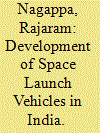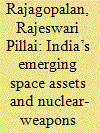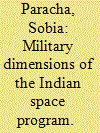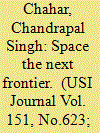| Srl | Item |
| 1 |
ID:
149792


|
|
|
|
|
| Summary/Abstract |
The Indian space program is a spacefaring success story with demonstrated capability in the design and building of application and scientific satellites, and the means to launch them into desired orbits. The end-to-end mission planning and execution capability comes with a high emphasis on self-reliance. Sounding rockets and small satellite launch vehicles provided the initial experience base for India. This experience was consolidated and applied to realize larger satellite launch vehicles. While many of the launch vehicle technologies were indigenously developed, the foreign acquisition of liquid propulsion technologies did help in catalyzing the development efforts. In this case, launch vehicle concept studies showed the inevitability of using a cryogenic upper stage for geosynchronous Earth orbit missions, which proved to be difficult technically and encountered substantial delays, given the geopolitical situation. However, launch capability matured from development to operational phases, and today, India’s Polar Satellite Launch Vehicle and Geosynchronous Satellite Launch Vehicle are in a position to meet both domestic and international market demands.
|
|
|
|
|
|
|
|
|
|
|
|
|
|
|
|
| 2 |
ID:
171174


|
|
|
|
|
| Summary/Abstract |
Over the last five decades, India’s nuclear and space programs have gone through several phases, from collaboration to divorce to supportive. An interplay of two factors determined the nature of the relationship. One was the state of India’s nuclear-weapon program. The second was international conditions, especially India’s relationship with the nuclear-nonproliferation regime. In the early decades, because of the rudimentary nature of India’s nuclear and space programs, the relationship was collaborative, since the rocket technology being developed was a necessary adjunct to the nuclear-weapon program. Subsequently, as India’s rocketry capabilities and nuclear-weapon program began to mature and concerns about international sanctions under the non-proliferation regime began to grow, the two programs were separated. The Indian rocketry program was also divided, with the civilian-space and ballistic-missile programs clearly demarcated. After India declared itself a nuclear-weapon state in 1998 and the programs matured, the relationship has become more supportive. As the two programs mature further, this relationship is likely to deepen, as the nuclear-weapon program requires space assets to build a robust and survivable nuclear deterrent force.
|
|
|
|
|
|
|
|
|
|
|
|
|
|
|
|
| 3 |
ID:
110121


|
|
|
| 4 |
ID:
124928


|
|
|
|
|
| Publication |
2013.
|
| Summary/Abstract |
The Indian space program is increasingly militarized. A clear policy shift in this direction has taken place. The transformation is happening because of international cooperation, especially in the civilian domain. In order to get foreign support, India projects the civilian image of its space program by arguing that there are bureaucratic and organizational barriers between civil and military programs that control internal diversion. At the same time, there exists evidence of civilian technology acquired through foreign sources being diverted for military use.
|
|
|
|
|
|
|
|
|
|
|
|
|
|
|
|
| 5 |
ID:
179315


|
|
|
|
|
| Summary/Abstract |
Use of space has fast spread to countries across the globe with enormous implications for security since each state seeks to develop offensive as well as defensive capabilities in space to pursue its security and other interests. India, too, was quick to recognise the potential of space exploration in the development of the country. With a modest start in year 1967 involving launch of first indigenously built sounding rocket from Thumba, the Indian space program has come a long way. The Indian space program has been a civilian one since its inception. With the growing dependence of the armed forces on space-based assets the military applications of this technology cannot be ignored. With each passing day the reliance on space assets is increasing manifold. It is important not only to launch more satellites to meet the growing demand of civilian use but also to meet its military applications. While it is essential to have adequate space assets to meet the ever-increasing requirements of communications, it is prudent to develop an effective anti-satellite weapon system as deterrence against any threat to these space assets. The article argues that if India is to maintain itself as a credible military power into the 21st century, it must exploit this medium.
“Expand on both sides as it is a Quote and not part of Abstract is no ambiguity of purpose. We do not have the fantasy of competing with the economically advanced nations in the exploration of the moon or the planets or manned space-flight. But we are convinced that if we are to play a meaningful role nationally, and in the comity of nations, we must be second to none in the application of advanced technologies to the real problems of man and society.”
|
|
|
|
|
|
|
|
|
|
|
|
|
|
|
|